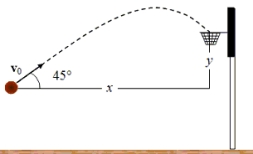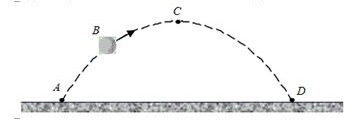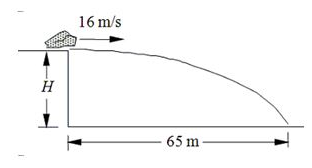A) 9.8 m/s2
B) 16.6 m/s2
C) 29.4 m/s2
D) 5.42 m/s2
E) zero m/s2
Correct Answer

verified
Correct Answer
verified
Multiple Choice
A shell is fired with a horizontal velocity in the positive x direction from the top of an 80-m high cliff. The shell strikes the ground 1330 m from the base of the cliff. The drawing is not to scale.
 -Determine the initial speed of the shell.
-Determine the initial speed of the shell.
A) 4.0 m/s
B) 9.8 m/s
C) 82 m/s
D) 170 m/s
E) 330 m/s
Correct Answer

verified
Correct Answer
verified
Multiple Choice
A bullet is aimed at a target on the wall a distance L away from the firing position. Because of gravity, the bullet strikes the wall a distance y below the mark as suggested in the figure. Note: The drawing is not to scale.  If the distance L was half as large and the bullet had the same initial velocity, how would y be affected?
If the distance L was half as large and the bullet had the same initial velocity, how would y be affected?
A) y will double.
B) y will be half as large.
C) y will be four times larger.
D) y will be one fourth as large.
E) y is not possible to determine unless numerical values are given for the distances.
Correct Answer

verified
Correct Answer
verified
Multiple Choice
A basketball is launched with an initial speed of 8.0 m/s and follows the trajectory shown. The ball enters the basket 0.96 s after it is launched. What are the distances x and y? Note: The drawing is not to scale.  x y
x y
A) 5.4 m 0.73 m
B) 7.7 m 0.91 m
C) 5.4 m 0.91 m
D) 5.7 m 0.73 m
E) 5.4 m 5.4 m
Correct Answer

verified
Correct Answer
verified
Multiple Choice
A tennis ball is thrown upward at an angle from point A. It follows a parabolic trajectory and hits the ground at point D. At the instant shown, the ball is at point B. Point C represents the highest  -Which statement is true concerning the ball when it is at C, the highest point in its trajectory?
-Which statement is true concerning the ball when it is at C, the highest point in its trajectory?
A) The ball's velocity and acceleration are both zero.
B) The ball's velocity is perpendicular to its acceleration.
C) The ball's velocity is not zero, but its acceleration is zero.
D) The ball's velocity is zero, but its acceleration is not zero.
E) The horizontal and vertical components of the ball's velocity are equal.
Correct Answer

verified
Correct Answer
verified
Multiple Choice
A rock is kicked horizontally at a speed of 15 m/s from the edge of a cliff. The rock strikes the ground 65 m from the foot of the cliff of height H as suggested in the figure, which is not drawn to scale. Neglect air resistance.
 -How long is the rock in the air?
-How long is the rock in the air?
A) 1.0 s
B) 1.2 s
C) 4.0 s
D) 5.5 s
E) 11.2 s
Correct Answer

verified
Correct Answer
verified
Multiple Choice
A passenger at rest on a flatbed train car fires a bullet straight up. The event is viewed by observers at rest on the station platform as the train moves past the platform with constant velocity. What is the trajectory of the bullet as described by the observers on the platform?
A) a straight horizontal path in the direction of the train's velocity
B) a straight vertical path up and down
C) a circular path centered on the gun
D) a straight diagonal path
E) a parabolic path
Correct Answer

verified
Correct Answer
verified
Multiple Choice
A tennis ball is thrown upward at an angle from point A. It follows a parabolic trajectory and hits the ground at point D. At the instant shown, the ball is at point B. Point C represents the highest  -While in flight, how do the x and y components of the velocity vector of the ball compare at the points A and D?
-While in flight, how do the x and y components of the velocity vector of the ball compare at the points A and D?
A) The velocity components are non-zero at A and are zero m/s at D.
B) The velocity components are the same in magnitude and direction at both points.
C) The velocity components have the same magnitudes at both points, but their directions are reversed.
D) The velocity components have the same magnitudes at both points, but the directions of the x components are reversed.
E) The velocity components have the same magnitudes at both points, but the directions of the y components are reversed.
Correct Answer

verified
Correct Answer
verified
Multiple Choice
A projectile is fired at an angle of 55.0° above the horizontal with an initial speed of 35.0 m/s. -What is the magnitude of the horizontal component of the projectile's displacement at the end of 2 s?
A) 30 m
B) 40 m
C) 10 m
D) 20 m
E) 50 m
Correct Answer

verified
Correct Answer
verified
Multiple Choice
A projectile fired from a gun has initial horizontal and vertical components of velocity equal to 30 m/s and 40 m/s, respectively. -Determine the initial speed of the projectile.
A) 40 m/s
B) 50 m/s
C) 60 m/s
D) 70 m/s
E) 80 m/s
Correct Answer

verified
Correct Answer
verified
Multiple Choice
A projectile is fired horizontally with an initial speed of 50.0 m/s. Neglect air resistance. -What is the magnitude of the displacement of the projectile 3.00 s after it is fired?
A) 29.4 m
B) 44.1 m
C) 150 m
D) 156 m
E) 194 m
Correct Answer

verified
Correct Answer
verified
Multiple Choice
A projectile fired from a gun has initial horizontal and vertical components of velocity equal to 30 m/s and 40 m/s, respectively. -What is the acceleration of the projectile when it reaches its maximum height?
A) zero m/s2
B) 9.8 m/s2, downward
C) 4.9 m/s2, downward
D) less than 9.8 m/s2 and non-zero.
E) Its magnitude is 9.8 m/s2; and its direction is changing.
Correct Answer

verified
Correct Answer
verified
Multiple Choice
A cannonball at ground level is aimed 30.0° above the horizontal and is fired with an initial speed of 125 m/s. How far away from the cannon will the cannonball hit the ground?
A) 125 m
B) 138 m
C) 695 m
D) 1040 m
E) 1380 m
Correct Answer

verified
Correct Answer
verified
Multiple Choice
A football is kicked with a speed of 18 m/s at an angle of 65° to the horizontal. -How long is the football in the air? Neglect air resistance.
A) 1.1 s
B) 1.6 s
C) 2.0 s
D) 3.3 s
E) 4.0 s
Correct Answer

verified
Correct Answer
verified
Multiple Choice
A delivery truck leaves a warehouse and travels 2.60 km north. The truck makes a left turn and travels 1.25 km west before making another right turn to travel 1.40 km north to arrive at its destination. What is the magnitude and direction of the truck's displacement from the warehouse?
A) 4.00 km, 18.2° north of west
B) 5.25 km, 59.8° north of west
C) 6.33 km, 70.2° north of west
D) 3.40 km, 55.0° north of west
E) 4.19 km, 72.6° north of west
Correct Answer

verified
Correct Answer
verified
Multiple Choice
A spaceship is observed traveling in the positive x direction with a speed of 150 m/s when it begins accelerating at a constant rate. The spaceship is observed 25 s later traveling with an instantaneous velocity of 1500 m/s at an angle of 55° above the +x axis. -What was the magnitude of the acceleration of the spaceship during the 25 seconds?
A) 1.5 m/s2
B) 7.3 m/s2
C) 28 m/s2
D) 48 m/s2
E) 57 m/s2
Correct Answer

verified
Correct Answer
verified
Multiple Choice
On a two lane highway, a car is following a pickup truck. At one instant, the car has a speed of 32 m/s and is 184 m behind the truck. At the same time, the truck has a speed of 28 m/s. If neither vehicle accelerates, how long will it take the car to catch up to the truck?
A) 4.8 s
B) 24 s
C) 46 s
D) 82 s
E) 96 s
Correct Answer

verified
Correct Answer
verified
Multiple Choice
Two cars approach each other on a straight and level road. Car A is traveling at 75 km/h, due north and car B is traveling at 45 km/h, due south. Both velocities are measured relative to the ground. -At a certain instant, the distance between the cars is 15 km. How long will it take, in seconds, from that instant for the two cars to meet?
A) 450 s
B) 900 s
C) 720 s
D) 1200 s
E) 1900 s
Correct Answer

verified
Correct Answer
verified
Multiple Choice
A basketball player is running at a constant speed of 2.5 m/s when he tosses a basketball upward with a speed of 6.0 m/s. How far does the player run before he catches the ball? Ignore air resistance.
A) 3.1 m
B) 4.5 m
C) The ball cannot be caught because it will fall behind the player.
D) 6.0 m
E) 7.5 m
Correct Answer

verified
Correct Answer
verified
Multiple Choice
A train travels due south at 60 m/s. It reverses its direction and travels due north at 60 m/s. What is the change in velocity of the train?
A) 120 m/s, due north
B) 120 m/s, due south
C) 60 m/s, due north
D) 60 m/s, due south
E) zero m/s
Correct Answer

verified
Correct Answer
verified
Showing 41 - 60 of 68
Related Exams